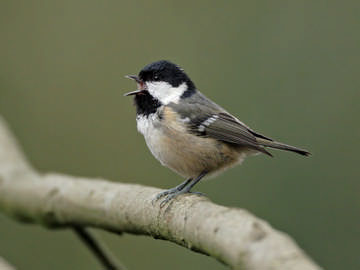
Coal Tit © Steve Round
Coal Tits are overwhelmingly birds of woodland, reported in this habitat in 335 tetrads, with only 16 records for scrub, 9 in hedgerow and 16 farmland: the contrast with Blue and Great Tits is stark. Coal Tit is also one of the few species that seems at home in coniferous woodland (A2), with 60 tetrad records. This was exceeded only by Goldcrest (75), and no other passerine registered in double figures. Gardens, in urban, suburban and rural areas, were used by many birds (154 tetrads in the F categories).
They are widespread across Cheshire and Wirral, present in two-thirds of tetrads, but are absent especially from the sparsely-wooded areas of the county, noticeably that in the central southern part of Cheshire, centred on Calveley (SJ65E), and in a band running as far as Tabley (SJ77D); the industrial and marshland belt across the south Mersey from Ellesmere Port (SJ37Y) to Frodsham (SJ57E); the western parts of Halton in SJ58; and the line of the River Gowy through SJ46 and SJ47. Coal Tits were absent from these last three areas twenty years ago, but have been lost from the former since our First Atlas, for unknown reasons that would repayfurther study. They were present in 334 tetrads in both Atlases, with 108 tetrads newly occupied since 1978-84, and 94 losses, giving little net change since our First Atlas.
This is by far the most difficult tit species in which to prove breeding (51% of records). Fieldworkers found birds carrying food or a faecal sac in 58 tetrads, and parties of recently fledged young in another 132; in only 37 tetrads were nests found. Nest sites reported included natural holes in trees, often low down or even underground amongst the roots, and a variety of man-made artefacts including nest-boxes, pipes and holes in walls, with Martyn Stanyer noting one pair in SJ85H on 15 May 2004 that was taking food into a nest hole in a wall, only 1 metre from an occupied Great Tit nest. Coal Tits apparently feed on a wider variety of invertebrates than other tits, and are more likely to have a second brood (Perrins 1979).
The BTO BBS analysis shows that the breeding population of the county in 2004-05 was 5,750 birds (2,990-8,520), corresponding to an average of about 10 pairs per tetrad with confirmed or probable breeding, or six pairs per tetrad in which the species was recorded. This is less than 0.5% of the UK breeding population of one million birds, reflecting Cheshire and Wirral’s status as one of the least wooded counties in England (National Inventory of Woodland and Trees, Forestry Commission 2003).
The national population has fluctuated but shows no clear trend in twenty years; this statement, however, conceals important habitat-specific changes. The numbers on English CBC plots in woodland have dropped slightly, whilst the totals on farmland plots have roughly doubled (Brown & Grice 2005). This behaviour is usually characteristic of a species whose population is high: it ‘fills up’ its natural habitat, and some individuals spill over into other, sub-optimal, habitats. This pattern of Coal Tits moving in to farmland has not been noted in Cheshire and Wirral, however, and perhaps depends on the detailed land-use of the agricultural landscape.
Sponsored by Denise Bebbington

